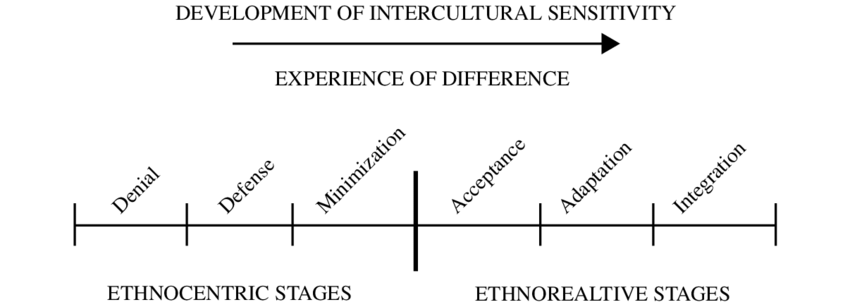Developmental Model of Intercultural Sensitivity
This article shows the theories of Milton Bennet and how he views the relationship, or degree of understanding, people have with other humans of a different culture. While reading, it was understood that there is a scale that someone can place themselves into. On one eld of the scale, a person is considered in denial. Denial is when you have no regard to another culture, and do not even see these people as humans. On the opposite end of the scale is integration. Integration is when a person is so open to other cultures that they often can feel comfortable in any cultural setting. These type of people judge other cultures very little and have a deep understanding of why they do what they do.
While reading this article, I found myself wondering where I fall in Bennet’s model. On one hand, I would like to think I am open to other cultures, even if it is different from what I am used to. In reality, I do not have a lot of experiences with people of different culture. I would say I am a part of the dominant culture where I live, so anyone who is not in the same culture as me, I can usually spot them and see differences. I do not think I would judge, but I would be curious and ask myself questions like, ” Why are they doing it so different from me?”, or “they are acting strange”. In the future, I hope to remember to look at these instances as understanding these “weird” cultural differences are normal to them, and not everything I do is normal for the rest of the world.

https://www.researchgate.net/figure/The-Developmental-Model-of-Intercultural-Sensitivity_fig1_344750735
The Values Americans Live by
Americans have values that we live by in our daily lives. These values are what we have been accustomed to in society and deem them as “normal” characteristics of our lives. Just a few of these common and shared values are, according to L. Robert Kohls, change, time and its control, equality, and informality. Even though Americans understand these are examples of our values in our society, other cultures might not understand them the way we do.
A value Americans share is informality. From language, dress, and mannerisms, the American culture is one of the most informal, as well as casual types of people in the world. In my life, I was personally not taught to be formal when talking to or meeting a new person. I was always uncomfortable when referring to a person as “ma’am” or “sir” , because growing up I never had that expectation. Instead, I would address people very casual as their first name, their last name and “mr” or “mrs”. In day to day life, I say “Hi” by nodding the head, or a simple smile instead of a formal greeting accompanied by a hug, handshake, or a quick chat. At first, I would expect an outsider to view this sort of behavior as disrespectful, and without knowledge of the American culture, it would not be a good impression. In other cultures, it is rude to be informal when interacting with other people, and on a daily basis. This is especially true of a culture that have a high standard of formality. If an American would be placed into one of these cultures and did not change the way they acted, those people would find them disrespectful and out of their own ordinary.

http://i3rglobal.com/blogs/is-informal-the-new-formal/
Conducting a Study Abroad Analysis
This week I studied multiple students who have written blogs during their experiences studying abroad. While browsing all of the blogs, I was interested in one particular student who shared her experience going from a completely virtual format for school to traveling to a foreign country on a semester in Germany. During her junior year of university, she was accepted into the exchange program where she would study at the University of Hamburg. There was a few themes that I noticed this student writing about. The main ones are culture shock and emotion. Off the bat, she was extremely worried about the language barrier, as well as how the culture shock will affect her social life in a new country. The first few entries she felt embarrassed for improperly understanding the language and non verbal gestures that she had come across when in the city of her university. Luckily enough, since this blog is still ongoing for her time in Germany, her most recent blog post is reflecting on the first six months studying abroad. She mentions the anxiety and stress she faced in the first few months of her trip. This put a toll on her mental health because it is hard to enjoy an experience like this when there is too much worry on the mind. It was great to see her realize the things that have helped her guide herself in the country better. The student explains how she studied and caught on all of the social cues that are relevant in the German culture. Getting used to the language, social slang, and directions to major places in Hamburg.
I have never studied abroad before. In fact, I have never even considered it as an option. After reading all the blogs made by these students and sharing their amazing experiences, it has made me realized what a great opportunity it is. I still am in the mindset that I am too busy and cannot afford it, but if an opportunity fell right in front of me, I would consider doing it.

https://www.studyabroad.com/in-germany/hamburg
Comparing Gender Representations Across Cultures
For this assignment takeaway, I researched multiple advertisements from two different cultures and studied how male and females are represented and how that effects the gender stereotype. The two different cultures I looked into are Korean and American. The Korean advertisements dealing with women are, as a whole, very clean-looking. The colors are bright pastels or white and there is simple graphics. The products that women tend to be advertising are beauty products and soaps. The advertisements that men were featured in have a lot more exciting colors and shapes, and there is more to look at. The products they are advertising are usually food or electronics. This comparison helps the stereotype that women are supposed to be beautiful, clean and dainty while the men are often the ones working and using electronics like phones, computers, and machines. The American advertisements Have a similar case. The advertisements that included women tended to show more skin and have an over-use of makeup. They also have more feminine colors like pink and purple, ad wells a lot of floral. Advertisements with men include a man who has enhanced masculine features like muscles, a beard, and a work uniform. They are designed to have a more tough theme with the use of silvers, plaid, and darker colors.

This photo represents the bright colors, clothing, and glam makeup that is used for women in American advertisements.